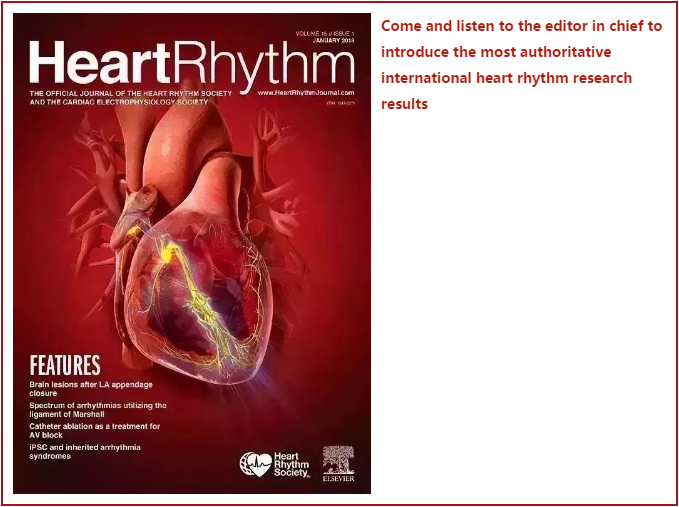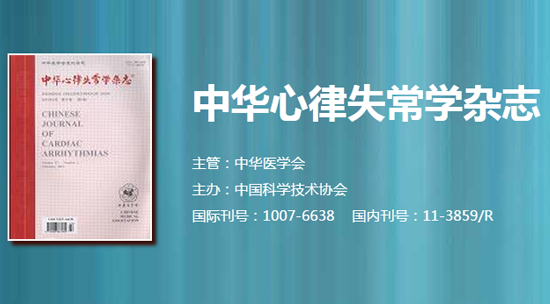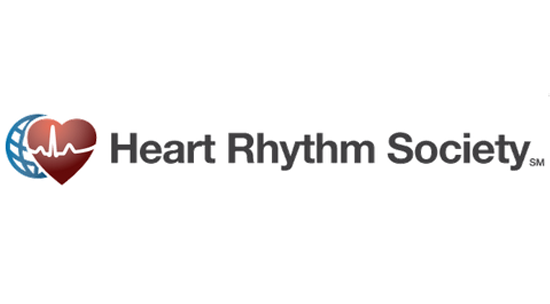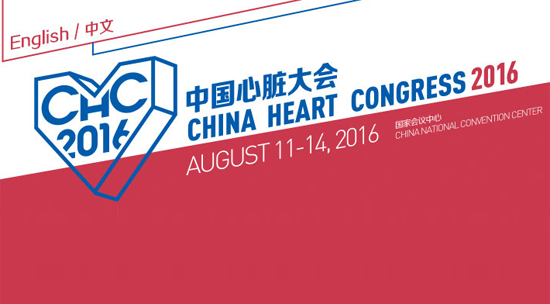HeartRhythm主编—陈鹏生教授语音速递(六月刊 英文版)
<< First issue in June 2021 >>


Peng-Sheng Chen
The featured article is titled “Racial Differences in Incidence of Atrial Fibrillation after Cryptogenic Stroke”. The authors retrospectively analyzed 416 consecutive patients undergoing insertable cardiac monitor implantation and follow-up for 1.5 years. They found that the incidence of newly detected AF is approximately double in whites compared with both blacks and Hispanics. This has important implications for the investigation and treatment of nonwhites with cryptogenic stroke.
The next article is “Blood biomarkers to detect new-onset atrial fibrillation and cardioembolism in ischemic stroke patients.”The authors prospectively collected from ischemic stroke patients multiple blood biomarkers, including NT-proBNP, d-dimer, S100β, neuron-specific enolase, vitamin D, cortisol, interleukin-6, insulin, uric acid, and albumin. Of the 515 ischemic stroke patients (mean age 61 years; 71% men), 44 (8.5%) were diagnosed with new-onset AF, and 75 (14.5%) had cardioembolism. The combination of 2 laboratory parameters and 2 or 3 biomarkers could identify patients with increased likelihood of new onset of AF and cardioembolism. Adding clinical predictors did not improve the performance of these models.
Next ups is “An Individualized Ablation Strategy to Treat Persistent Atrial Fibrillation: Core-to-Boundary Approach Guided by Charge-Density Mapping.”The authors used noncontact charge-density mapping for rapid real-time global mapping of atrial fibrillation (AF). They then compared the 2-year outcome of an individualized strategy consisting of pulmonary vein isolation plus core-to-boundary ablation (targeting the conduction pattern core with an extension to the nearest nonconducting boundary) guided by charge-density mapping, with an empirical PVI plus posterior wall electrical isolation strategy. The authors found that an individualized ablation strategy consisting of PVI plus core-to-boundary ablation guided by noncontact charge-density mapping is a feasible and effective strategy for treating persistent AF, with a favorable 24-month outcome.
Coming up next is “Oral Anticoagulants in Extremely High Risk Very Elderly (>90 years) Patients with Atrial Fibrillation.” The authors used the Taiwan National Health Insurance Research Database to identify high-risk, very elderly subjects taking oral anticoagulants (OAC) and compared them to non-OAC users for the composite net clinical endpoint of ischemic stroke, intracranial hemorrhage, major bleeding, or mortality. They found that warfarin was associated with a similar or even higher risk of composite clinical outcomes compared to non-OACs. Non-vitamin K OACs were associated with a lower risk of composite endpoint compared to warfarin or non-OACs, and their use should be considered in these high-risk, very elderly AF patients.
The following article is “Does Pulsed Field Ablation Regress Over Time? A Quantitative Temporal Analysis of Pulmonary Vein Isolation.” Pulsed field ablation (PFA) is an attractive energy source for PV isolation. However, beyond each PFA lesion's zone of irreversible electroporation and cell death, there may be a surrounding zone of reversible electroporation and cell injury that could potentially normalize with time. In a clinical trial using biphasic PFA waveform, detailed voltage maps were created using a multispline diagnostic catheter immediately after PFA and again ∼3 months later. There was no significant difference in either the left- and right-sided PV antral isolation areas or nonablated posterior wall area. The distances between low-voltage edges on the posterior wall were also not significantly different between the 2 time points. This study demonstrates that the level of PV antral isolation after PFA with a multielectrode PFA catheter persists without regression.
Next up is “Catheter Ablation of Ventricular Tachycardia in Ischemic Cardiomyopathy: Impact of Concomitant Amiodarone Therapy on Short and Long-Term Clinical Outcomes.” A total of 134 consecutive patients were included in the study. In 84 patients (63%), the ablation was performed on amiodarone; the remaining 50 patients (37%) were off amiodarone. During mean follow-up of 24 months, recurrence of any ventricular arrhythmias off antiarrhythmic drugs was 44% (37/84) in the on-amiodarone group vs 22% (11/50) in the off-amiodarone group. Although patients on amiodarone required less radiofrequency time and less need for epicardial ablation, these patients had significantly higher VT recurrence at long-term follow-up when amiodarone was discontinued.
The following article is “Ventricular tachycardia burden reduction after substrate ablation: predictors of recurrence.” The purpose of this study was to assess VT burden reduction during long-term follow-up after substrate ablation and identify predictors of VT recurrence. The authors analyzed 234 consecutive VT ablation procedures in 207 patients. After follow-up of 3.14 years, the VT recurrence rate was 41.4%. Overall, a 99.6% reduction in VT burden and a 96.3% decrease in ICD shocks were observed. Lower ejection fraction and persistence of late potentials are predictors of recurrence.
The next article is “Assessment of patients presenting with life-threatening ventricular tachyarrhythmias and suspected myocarditis: the key role of endomyocardial biopsy.” The authors enrolled 54 consecutive patients with normal ventricular function. In 31 patients, the histological diagnosis was myocarditis, while in 14 patients, focal replacement myocardial fibrosis and in 9 patients, specimens were inadequate. At a follow-up of 21 months, histological diagnosis of myocarditis and RV endocardial scar were independent predictors of sustained ventricular arrhythmias. These data highlight the need for 3D-electroanatomic mapping-guided endomyocardial biopsy in apparently healthy young patients with suspected myocarditis and ventricular arrhythmias.
Next ups is “Spatial and Transmural Properties of the Reentrant Ventricular Tachycardia Circuit in Arrhythmogenic Right Ventricular Cardiomyopathy: Simultaneous Epicardial and Endocardial Recordings”. The purpose of this study was to delineate the reentrant VT circuit with simultaneous epicardial and endocardial mapping in 23 consecutive ARVC patients. Of the 30 VT circuits, 24 were delineated. There is a consistent predominance of epicardial participation during reentry in ARVC. Only the perivalvular inflow region of the "triangle of dysplasia" had a strong propensity to harbor VT circuits, with the greatest proportion located in the inferior wall. Localized epicardial reentry may be a manifestation of earlier stage disease with a relative paucity of endocardial substrate.
The following article is “Temperature Monitoring and Temperature-driven irrigated Radiofrequency Energy Titration do not prevent thermally-induced Esophageal Lesions in Pulmonary vein isolation: A randomized study controlled by esophagoscopy before and after catheter ablation”. The purpose of this study was to study (1) the benefit of luminal esophageal temperature monitoring and (2) the impact of esophagogastroduodenoscopy. The primary endpoint was the number of ablation-induced lesions. Eight of 86 patients developed esophageal lesions. Temperature overshooting ≥42°C was associated with a higher risk for new lesions. The authors conclude that monitoring of luminal esophageal temperature does not prevent ablation-induced esophageal lesions. Patients without temperature surveillance were not at higher risk, but temperatures ≥42°C were associated with increased likelihood of mucosal lesions.
Coming up next is “Physiology-Based Electrocardiographic Criteria for Left Bundle Branch Capture”. The authors hypothesized that because LBB pacing results in physiological depolarization of the LV, then the native QRS can serve as a reference for diagnosis of LBB capture in the same patient. A total of 357 ECGs from 124 patients were analyzed: 118 with native rhythm, 124 with nonselective LBB capture, 69 with selective LBB capture, and 46 with LV septal capture. The authors compared the paced and native V6 R-wave peak time. They showed equivalency of LV activation times on ECG during native and paced LBB conduction. Therefore, if V6 R-wave peak time is longer during pacing, this finding is indicative of lack of LBB capture.
The next paper is also about LBB pacing, titled “The Relationship of Paced Left Bundle Branch Pacing Morphology with Anatomic Location and Physiologic Outcomes”. The purpose of this study was to explore pacing and physiological characteristics associated with different LBB pacing locations. The study included 68 consecutive patients with normal unpaced QRS duration and successful LBBP implantation. Patients were divided into 3 groups according to the paced QRS complex as left bundle branch trunk pacing, left posterior fascicular pacing, or left anterior fascicular pacing. Fluoroscopic imaging indicated that the lead tip was located most commonly in the basal-middle region of the septum independent of paced QRS morphology group. These data show that pacing at different sites of the LBB resulted in similar intraventricular and interventricular electrical synchrony in patients with an intact conduction system. Fluoroscopic imaging alone could not predict specific LBBP paced ECG morphology.
Next up is “Extent of peri-infarct scar on late gadolinium enhancement cardiac magnetic resonance imaging and outcome in patients with ischemic cardiomyopathy.” The authors studied 216 patients with ischemic cardiomyopathy underwent CMR imaging before primary or secondary ICD implantation and prospectively followed up the patients for 1497 days. They found that scar extent of peri-infarct border zone was significantly associated with appropriate ICD therapy. Thus, LGE-CMR parameters can identify a subgroup of patients with ischemic cardiomyopathy and an increased risk of life-threatening ventricular tachyarrhythmias.
The following paper is “Prognosis of patients with severe left ventricular dysfunction after transvenous lead extraction and the need for additional hemodynamic support in he perioperative period.” The authors studied 36 patients with severe LV dysfunction (LVEF<=35%) undergoing transvenous lead extraction and compared their mortality than those with LVEF > 35%. The authors found no significant between-group differences in major complications and clinical success rates. Patients with severe LV dysfunction were more likely to require additional hemodynamic support. The survival rate was not significantly different between the groups at 30 days and 1 year after transvenous lead extraction.
The next article is “The benefits of routine prophylactic femoral access during transvenous lead extraction.” The authors conducted a retrospective analysis of 285 patients who underwent transvenous lead extraction. Femoral sheaths were actively engaged in 9.1% (n = 26) of cases. Deployment of snares was the most common intervention (n = 10), followed by prophylactic or emergency placement of occlusion balloons, temporary pacing, venous angioplasty, diagnostic venography, and extracorporeal membrane oxygenation. The authors conclude that routine prophylactic placement of femoral sheaths shortens response time and quickly establishes control in the event of various complications that may occur during transvenous lead extraction procedures.
The following paper is “Competing Risks in Patients with Primary Prevention Implantable Cardioverters Defibrillators: Global Electrical Heterogeneity and Clinical Outcomes (GEHCO) Study.” The purpose of this study was to investigate whether global electrical heterogeneity is associated appropriate ICD therapies in patients with heart failure and primary prevention ICDs. Global electrical heterogeneity was measured by spatial ventricular gradient direction and magnitude, QRS-T angle, and sum absolute QRST integral on preimplant 12-lead ECGs. They analyzed 2668 patients and found that global electrical heterogeneity is independently associated with appropriate ICD therapies. The spatial ventricular gradient vector points in distinctly different directions in patients with 2 competing outcomes.
The next article is “Racial Disparities in the Utilization and In-Hospital Outcomes of Percutaneous Left Atrial Appendage Closure Among Patients with Atrial Fibrillation”. The authors identified 16,830 hospitalizations for percutaneous Left Atrial Appendage Closure (pLAAC) using the National Inpatient Sample. Black/African American patients represented 4.1% of nationwide pLAAC recipients and were younger, more likely to be female, and had greater prevalence of hypertension, heart failure, hyperlipidemia, obesity, chronic kidney disease, and prior stroke history. After controlling for possible confounding factors, Black/AA race was independently associated with significantly increased odds of bleeding requiring blood transfusion, stroke, venous thromboembolism, and nonroutine discharge. This study highlights the importance of addressing ongoing racial disparities in both utilization and outcomes of pLAAC.
Next up is “The right ventricular insertion promotes the reinitiation of ventricular fibrillation in defibrillation failure.” The purpose of this study was to determine whether wavebreak leading to VF reinititation following near defibrillation threshold shocks occurs preferentially at the right ventricular insertion, which previous studies have identified as a key site for wavebreak. The authors used panoramic optical mapping to image the ventricular epicardium of 6 isolated swine hearts. After each experiment, the hearts were fixed and their geometry scanned with MRI. The results show that the anterior RV insertion is a key site in promoting defibrillation shock failure. Targeting this site to prevent wavebreak could convert defibrillation failure to success and improve defibrillation efficacy.
Up next is “Absence of (sub-) acute cerebral events or lesions after electroporation ablation in the left-sided canine heart.” Irreversible electroporation (IRE) can create gas bubbles at the ablation electrode. Cerebral effects of these bubbles are unknown. In 11 canines, baseline cerebral MRI scans were performed. At days 1 and 5 after ablation, MRI was repeated. The brain tissue then was histopathologically examined. Intracardiac echography confirmed gas bubble formation after each IRE application. Neurologic examination was normal. MRI images alone or in combination with histologic follow-up did not reveal treatment-related embolic events. Gross and microscopic pathology did not reveal evidence of treatment-related embolic events. IRE seems to be a safe ablation modality for the brain.
These original articles are followed by two contemporary reviews. The first one is titled “Evolution of risk stratification and sudden death prevention in hypertrophic cardiomyopathy: 20 years with the implantable cardioverter-defibrillator”. The second one is titled “Optimizing lead placement for pacing in dyssynchronous heart failure: the patient in the lead”.
Dr Alfred Buxton wrote a Viewpoint titled “Thirty Years of Catheter Ablation for Ventricular Tachycardia” as the 6th entry in our series of articles to celebrate the 30th year of RF ablation. Among the letters to editors, there is one titled “Life Saving Therapy Inhibition by Phones Containing Magnets”. The authors reported the magnet in Apple iPhone 12 was able to cause suspension of therapy by a Medtronic ICD.
I hope you enjoyed this podcast. For Heart Rhythm, I’m the Editor-In-Chief, Dr. Peng-Sheng Chen.











